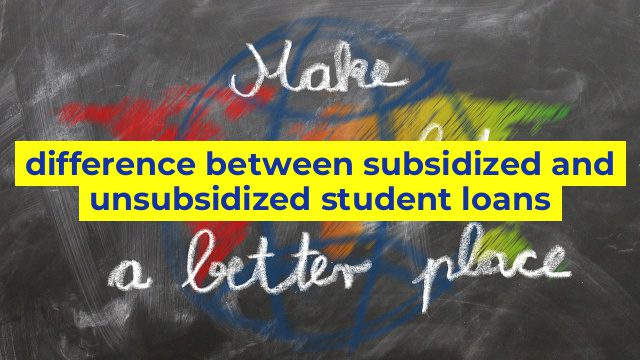What is the Difference between Subsidized and Unsubsidized Student Loans?
When it comes to financing your higher education, student loans are the most common way to obtain the necessary funds. However, not all student loans are the same, and understanding the differences between subsidized and unsubsidized student loans can help you make an informed decision.
Subsidized Student Loans
Subsidized student loans are loans that the federal government offers to undergraduate students who demonstrate financial need. The government pays the interest on the loan while you are enrolled in school at least half-time, during the grace period, and during any deferment periods you might have.
The interest rate for subsidized federal loans is fixed by the government, and it is generally lower than the interest rates for other types of loans. Payment of subsidized student loans typically begins six months after graduation.
Unsubsidized Student Loans
Unsubsidized student loans, on the other hand, are available to both undergraduate and graduate students without regard to the student’s financial needs. While the loan gives you the necessary funds to cover education costs, the interest starts accruing from the time you receive the loan. This means that the longer it takes you to pay back the loan, the more interest you will have to pay over the life of the loan.
Another important difference between subsidized and unsubsidized loans is the interest rate. Unlike subsidized loans, the interest rate for unsubsidized federal loans is not fixed, and it can vary from year to year. Payment of unsubsidized loans begins six months after graduation as well.
Conclusion
In conclusion, the primary difference between subsidized and unsubsidized student loans is how interest is paid. Subsidized loans are more favorable because the government pays the interest while you attend school, whereas you will start accruing interest immediately on unsubsidized loans. Before choosing to take out a student loan, make sure to do your research ensure you have a clear understanding of the terms and conditions involved in each option. Ultimately, choosing the right student loan can help ensure you can achieve your academic goals without creating unnecessary financial stress.
Table difference between subsidized and unsubsidized student loans
| Subsidized Student Loans | Unsubsidized Student Loans |
|---|---|
| Interest is paid by the government while the student is in school at least half-time and during deferment periods. | Interest accrues while the student is in school and during deferment periods. The student is responsible for paying all interest. |
| Available only to undergraduate students who demonstrate financial need. | Available to undergraduate and graduate students regardless of financial need. |
| A maximum amount is determined by the student’s financial need and grade level. Annual limits are set by the government. | A maximum amount is determined by the student’s cost of attendance and grade level. Annual and aggregate limits are set by the government. |
| Repayment begins 6 months after the student graduates, leaves school, or drops below half-time enrollment. | Repayment begins 6 months after the student graduates, leaves school, or drops below half-time enrollment. Students can choose to make interest payments while in school to lower overall cost of the loan. |
| Students must complete the FAFSA to be considered for subsidized loans. | Students must complete the FAFSA to be considered for unsubsidized loans. |

